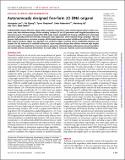| dc.contributor.author | Zhang, Fei | |
| dc.contributor.author | Qi, Xiaodong | |
| dc.contributor.author | Yan, Hao | |
| dc.contributor.author | Jun, Hyungmin | |
| dc.contributor.author | Shepherd, Tyson R | |
| dc.contributor.author | Ratanalert, Sakul | |
| dc.contributor.author | Bathe, Mark | |
| dc.date.accessioned | 2019-03-07T14:12:07Z | |
| dc.date.available | 2019-03-07T14:12:07Z | |
| dc.date.issued | 2018-11 | |
| dc.date.submitted | 2018-08 | |
| dc.identifier.issn | 2375-2548 | |
| dc.identifier.uri | http://hdl.handle.net/1721.1/120776 | |
| dc.description.abstract | Scaffolded DNA origami offers the unique ability to organize molecules in nearly arbitrary spatial patterns at the nanometer scale, with wireframe designs further enabling complex 2D and 3D geometries with irregular boundaries and internal structures. The sequence design of the DNA staple strands needed to fold the long scaffold strand to the target geometry is typically performed manually, limiting the broad application of this materials design paradigm. Here, we present a fully autonomous procedure to design all DNA staple sequences needed to fold any free-form 2D scaffolded DNA origami wireframe object. Our algorithm uses wireframe edges consisting of two parallel DNA duplexes and enables the full autonomy of scaffold routing and staple sequence design with arbitrary network edge lengths and vertex angles. The application of our procedure to geometries with both regular and irregular external boundaries and variable internal structures demonstrates its broad utility for nanoscale materials science and nanotechnology. | en_US |
| dc.description.sponsorship | National Science Foundation (U.S.) (Grant CCF-1564025) | en_US |
| dc.description.sponsorship | National Science Foundation (U.S.) (Grant CMMI-1334109) | en_US |
| dc.description.sponsorship | Office of Naval Research (Grant N000141210621) | en_US |
| dc.publisher | American Association for the Advancement of Science (AAAS) | en_US |
| dc.relation.isversionof | http://dx.doi.org/10.1126/sciadv.aav0655 | en_US |
| dc.rights | Creative Commons Attribution NonCommercial License 4.0 | en_US |
| dc.rights.uri | https://creativecommons.org/licenses/by-nc/4.0/ | en_US |
| dc.source | Science Advances | en_US |
| dc.title | Autonomously designed free-form 2D DNA origami | en_US |
| dc.type | Article | en_US |
| dc.identifier.citation | Jun, Hyungmin et al. “Autonomously Designed Free-Form 2D DNA Origami.” Science Advances 5, 1 (January 2019): eaav0655 © 2019 The Authors | en_US |
| dc.contributor.department | Massachusetts Institute of Technology. Department of Biological Engineering | en_US |
| dc.contributor.department | Massachusetts Institute of Technology. Department of Chemical Engineering | en_US |
| dc.contributor.mitauthor | Jun, Hyungmin | |
| dc.contributor.mitauthor | Shepherd, Tyson R | |
| dc.contributor.mitauthor | Ratanalert, Sakul | |
| dc.contributor.mitauthor | Bathe, Mark | |
| dc.relation.journal | Science Advances | en_US |
| dc.eprint.version | Final published version | en_US |
| dc.type.uri | http://purl.org/eprint/type/JournalArticle | en_US |
| eprint.status | http://purl.org/eprint/status/PeerReviewed | en_US |
| dc.date.updated | 2019-02-15T14:29:20Z | |
| dspace.orderedauthors | Jun, Hyungmin; Zhang, Fei; Shepherd, Tyson; Ratanalert, Sakul; Qi, Xiaodong; Yan, Hao; Bathe, Mark | en_US |
| dspace.embargo.terms | N | en_US |
| dc.identifier.orcid | https://orcid.org/0000-0002-7108-1288 | |
| dc.identifier.orcid | https://orcid.org/0000-0001-7122-1917 | |
| dc.identifier.orcid | https://orcid.org/0000-0002-1766-807X | |
| dc.identifier.orcid | https://orcid.org/0000-0002-6199-6855 | |
| mit.license | PUBLISHER_CC | en_US |
